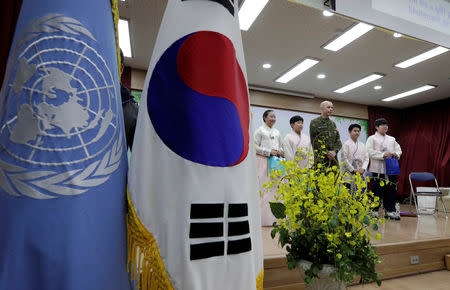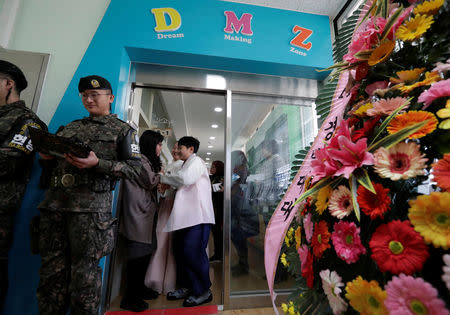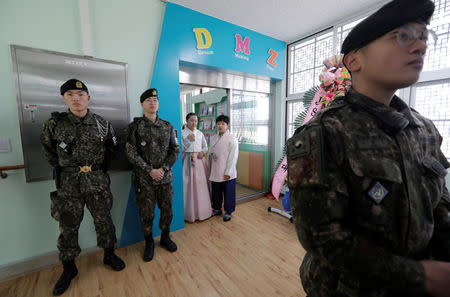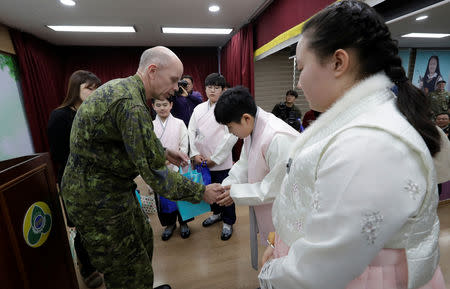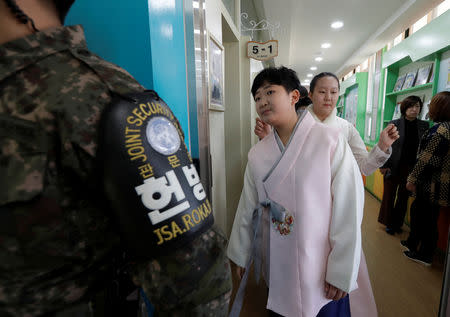Thaw in Korean ties brings relief for students of South's school in DMZ
By Hyonhee Shin
TAESUNG FREEDOM VILLAGE, South Korea (Reuters) - North Korea had been a source of fear for 11-year-old South Korean Sin Jae-hyeok as long as he could remember, until the moment he handed flowers to its leader, Kim Jong Un, ahead of the first summit with the South's president last April.
For the students of Daesungdong Elementary School, located in the Demilitarised Zone (DMZ), a 4-km (2.5-mile) buffer between North and South along one of the world's most heavily fortified borders, the dramatic detente came as a surprise.
"There were so many people around us and I was too nervous to see him, and our president as well," Sin, one of the school's students, told Reuters, describing his encounter with Kim ahead of the border summit.
"But actually he was nice and spoke in a friendly way."
The impoverished, isolated North and the wealthy, democratic South are still technically at war after their 1950-53 war ended in a truce, rather than a peace treaty.
Most of the school's 29 pupils make an hour-long bus ride each way to the border city of Paju, rattling past anti-tank barricades, barbed-wire fences and as many as four military checkpoints.
In the past, loudspeakers blaring propaganda from both sides made it impossible for the students to play outside, and they faced the risk of occasional exploding landmines swept along by floodwaters during the rainy seasons.
That is no longer the case, say students and residents, as the neighbours moved to defuse tension after the summit, clearing the DMZ of loudspeakers, landmines and weapons.
"The overall atmosphere is great and people are lively," said Kim Dong-ku, head of the tiny Taesung Freedom Village, where the school is located.
"We still can't believe it - just a while ago, everyone was talking about possible U.S. military action against North Korea."
Just eight of the 29 students came from the village last year, with the rest chosen by lottery, making a total just short of a quota of 30 agreed with the United Nations Command (UNC) that oversees DMZ affairs.
North Korea also has a primary school on the northern side of the border in line with the U.N. settlement.
Students in the South, who pay no fees for classes or meals, have another strong incentive to attend. Volunteer soldiers from the U.S.-led UNC provide extracurricular lessons in English, a subject for which many parents otherwise pay for costly private lessons.
With 15 candidates vying for every place, competition has grown tougher this year, an increase of about 50 percent over previous years, boosted by the rapprochement effort, Kim said.
"It allows us to get some positive outreach within the community," said Daniel McShane, an American Navy lieutenant commander, who has been teaching the students for six years. "For me personally, I've made a lot of friends here."
Four students graduated from the school on Friday, at a gathering of about 150 people, including 30 soldiers from the UNC and Sweden and Switzerland, which are members of the Neutral Nations Supervisory Commission that monitors the 1953 armistice.
One graduate, Jo Jun-young, said the six years he spent at the school, and the recent thaw in relations, had changed his view, not only on North Korea, but also unification.
"I used to think of North Korea as a scary place, especially after soldiers defected through the DMZ," the 12-year-old said.
"Unification may be far away, but I want to go there and make friends if it happens."
(Reporting by Hyonhee Shin; Additional reporting by Yijin Kim; Editing by Clarence Fernandez)



